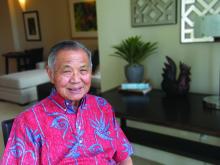A few years before the launch of Pediatric News in 1967, Dr. Henry Kempe and his colleagues at the University of Colorado, Denver, published a groundbreaking report on child abuse, “The Battered Child Syndrome,” in JAMA.
It had a major impact on Calvin C.J. Sia, MD, a now-retired pediatrician in Hawaii, not only because it was pioneering work and one of the milestones of 20th century pediatrics, but also because Dr. Kempe was a close friend and mentor of Dr. Sia, going back to when Dr. Sia was a resident in the 1950s.
Dr. Kempe “alerted me to the battered child syndrome and taught me the importance of looking at the whole child within the context of the family, and he repeatedly reminded me of the importance of preventive care. He taught me how to make preventive change, with the emphasis on the first 3 years” of life, Dr. Sia said in an interview from his home in Honolulu.
To celebrate the 50th anniversary of Pediatric News, it seemed appropriate to turn to Dr. Sia. His practice, launched in 1958, not only spanned our 50 years, but also illustrated one of the major themes in pediatrics over the past half-century. With the old scourges of infectious disease, malnutrition, and infant mortality largely brought under control, pediatrics turned to the broader struggles of childhood, including learning, poverty, and abusive parenting.
Furthermore, the work of Dr. Sia – a lifelong child advocate and one of the earliest champions of the “medical home” concept – illustrates the behind-the-scenes maneuvering that made the shift happen. “We can’t do it alone as pediatricians. I recognized that. You have to get involved with organized medicine to get things done,” he said.Dr. Sia has been president of the Hawaii Medical Association; president of the Hawaii chapter of the American Academy of Pediatrics; chief of staff at the Kauikeolani Children’s Hospital, Honolulu (now the Kapi‘olani Medical Center for Women and Children); chair of the American Medical Association Pediatric Delegation; and founder of the AMA’s Section Council on Pediatrics.
Positions like these eventually led him to contacts with legislators willing to listen and fund child abuse prevention, immunization programs, and other initiatives to help children. It often meant lobbying politicians for money.
“It doesn’t occur overnight; it takes chance and dedication,” said Dr. Sia, whose name, as one of its earliest champions, is now nearly synonymous with the concept of the medical home – an ideal of cradling children in a physician, family, and social services safety net of coordinated care.
Dr. Sia’s career spanned all of the developments that Pediatric News has covered over its 50 years, including the increasing recognition of autism, the earlier survival of premature infants, and phenylketonuria and other screenings at birth. He remembers all of them, and took action on many at the state and federal level.
Taking a step took courage, even when he wasn’t quite sure what to do. “I recognized autism back in the 60s. Children looked normal, were born normal, but then had trouble. I didn’t know what to do with them. That’s how I got involved with learning disabilities. I didn’t know anything, but I got involved,” he said.
With the advice of Robert Cooke, MD, another mentor and an eventual founder of the Head Start program, Dr. Sia cofounded Honolulu’s Variety School for Learning Disabilities in 1967. It’s still in operation; Don Ho and other local “variety hour” entertainers helped with early fundraising.
Dr. Sia also helped launch Healthy Start, one of the nation’s first home visit programs for at-risk kids, and an amendment to the federal Education of the Handicapped Act to extend aid to children with family and developmental challenges.
He convinced Sen. Daniel Inouye, another personal friend, to introduce the Emergency Medical Services for Children Act in the 1980s, which funded states to develop emergency medical services for children. “It was really important because kids need special instruments, IVs, and medications. I had to lobby. It was under Reaganomics,” Dr. Sia said.
At 89 years of age and recovering from a recent heart attack and open heart bypass, he is still trying to help children. Dr. Sia, who was born in Beijing, has been promoting the medical home concept in Asia. Meanwhile, he said he is worried about the fragmentation of health care in the United States, and the likely cutback in federal and state spending on kids.
Even so, “I believe in the future. I see in the generation coming up much more awareness of the whole child. I think they are going to do a much better job than I did,” but they need to learn “how to work the system.” Young physicians also must be mentored to believe in themselves, and take up the torch, he said.


